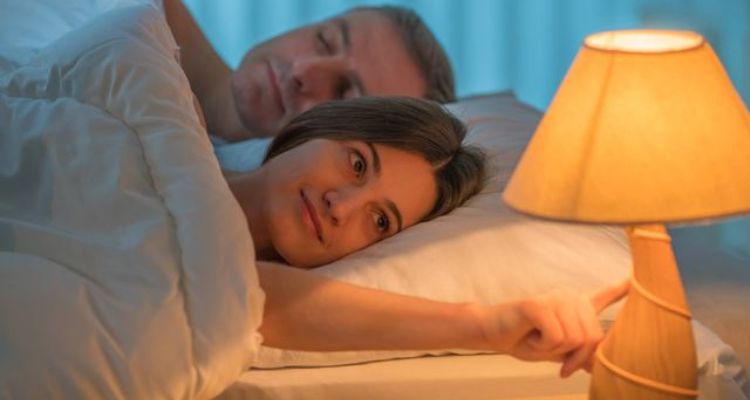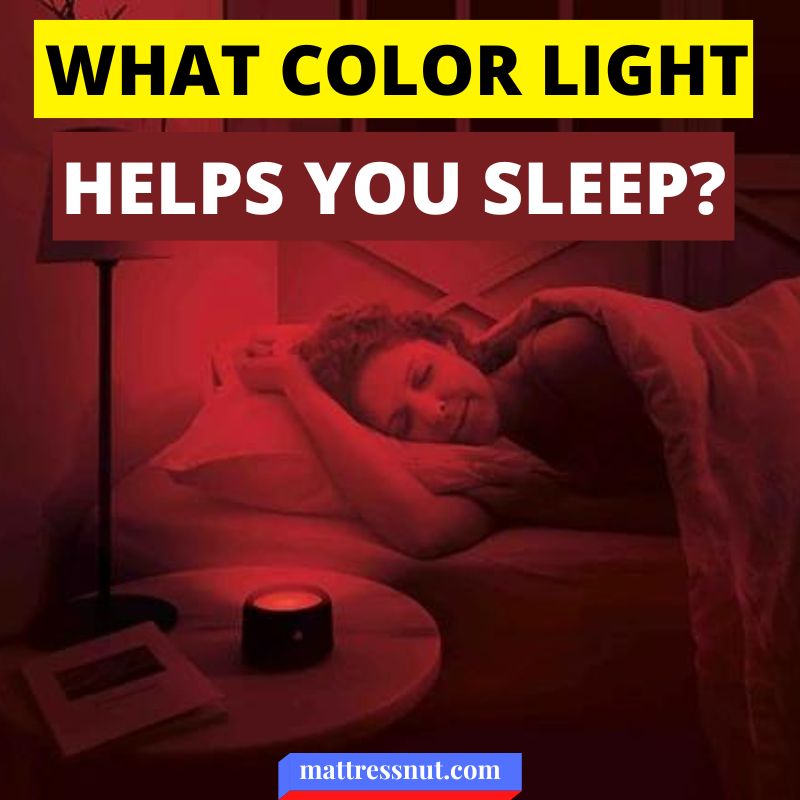Color psychology has a lot to do with what we think and what it means for us. Apart from the cultural significance, these colors impact our psychological reactions. Specific colors are exciting, some can intimate you, and some may pacify you.
Relaxing colors have a great impact on the place and ambiance. For instance, you might feel it is either colder or warmer with a change in the bulb’s light. Such changes can have an impact on our psyche.
So, what color light helps you sleep? Let’s dive into different lights, environmental cognition, and their properties.
Light and Our Environmental Cognition?
It is seen that light offers visual effects to recognize, see, and make contrasts in terms of perception, along with psychological and biological products.

Light helps improve mood, cognition, and the well-being of an individual. It plays an important role in perceiving things around us. Light helps in memorizing and understanding things for what we plan to interpret. This proves that light plays an important role in environmental cognition.
Light, saturation, brightness, or lack of light can cause impairment of melatonin production. The light in a room can affect your sleep pattern based on the hue of different lights.
How Light Can Help You Sleep Faster?
Lightning affects sleepiness and emotions. It can affect the sleep cycle, mood, and physical and mental health.
For instance, direct intense light can stress you, making you anxious and restless. It results in sleep anxiety and wakefulness. Contrarily, low overhead lights with warm colors make you feel relaxed. Using bright lights with cool tones can help in focusing on work with more concentration.
So, if you are seeking light for sleep, choose warm or low lights.
Best Color Lights for Sleep
Amber Light
Amber light helps produce melatonin, which results in increased sleep. Some of the modern lights in our environment these days emit blue light, including TVs, electronic devices, or other sources. Such devices result in disrupting melatonin secretion and confusing the circadian rhythms.
Amber light is warm and has no adverse effects on melatonin secretion. It has the same wavelength as a candle, making it an excellent choice for people.
Red Light
Red light has a strong influence on how well we sleep. For instance, you can use the red light for immediate sleeping after pre-routine bedtime rituals like guided breathing exercises, meditation, and performing yoga before bedtime.
You can choose red light in bedrooms or bathrooms because it makes you feel comfortable (also check the most comfortable mattresses). Red light comes at a wavelength that encourages the brain to increase the melatonin hormone production that helps the body sleep. Red color tends to avoid making your eyes sensitive. The eyes have photosensitive cells, which effectively set circadian rhythms and our body’s internal clock.
According to a study, using red light aids in inhibiting the secretion of melatonin. So, the brain believes it’s nighttime and makes us sleep.
The combination of red and amber lights will help you stay calm and relaxed during sleep.
When Should You Use Amber Light and Red Light Colors?
Red lights are great for bathrooms and bedrooms, offering you enough light and glow with a calm, relaxing feel.
Amber light is for brightness throughout the house. It provides sufficient colors and brightness, helping you avoid blue light while creating a relaxing environment.
What Are the Benefits of Calming Colors for Sleep?
If you are sleep-deprived, you need something to help you sleep. A bad night’s sleep can result in fatigue and tiredness, having a negative impact on your overall health. Light has a significant impact on our sleep. The benefits of light on sleep include the following:
Natural Melatonin Secretion:
The calm colors help in producing more melatonin than light colors. Red lights don’t make your brain alert or sensitive, leading to a calm sleeping experience.
Feeling Calm and In Tune with Your Internal Biological Clock
The calm colors do not affect your internal biological clock much and won’t negatively affect your circadian rhythms, so it’s beneficial for mental and physical health.
Preventing Sleep Inertia
Exposure to calm lights during and before sleep prevents you from experiencing the groggy feeling you might encounter once you wake up. A study shows that light colors result in restful sleep with better cognitive performance and prevention of sleep inertia.
When You Wake Up, You Feel More Alert And Focused.
Using calm lights shows you’ll feel more concentrated and alert once you wake up.
Better And More Restful Sleep.
Calm colors help improve cognitive performance, leading to more restful and peaceful sleep.
Relaxation Of The Muscles
Different colored lights help relax muscles with an overall calming effect. It helps reduce tension and fatigue, contributes to mental and physical health, and leads to peaceful sleep.
What Color of Light Promotes the Best Sleep for Babies and Children?
Children and babies are negatively affected if you expose them to white and blue lights. Warm colors are advised, especially for nighttime. Yellow and whitish blue colors impact the sleep level of children (also check 10 great mattresses for kids).

Researchers have concluded that children have higher suppression of melatonin than adults when exposed to whitish blue light. Contrarily, yellow light evenly suppresses melatonin secretion in both adults and children.
If infants are exposed to different bright lights during nursing time, it can have a negative impact on overall health.
What Are the Most Relaxing Light Colors?
The most selected light colors are blue, red, pink, and green. The blue light is great for post-rest relaxation. The white light has a calming effect and helps get your work done. It is useful for your cognitive performance, making you feel better when performing activities. It helps in tackling the inner balance, keeping you calm and peaceful. A red light, on the other hand, has the potential to make people calm.
The wavelength of the red color comes in the longest length compared with different colors. The body cannot react to red light, which is great. A wavelength of red light will make you feel relaxed. Pink light, however, has calming effects on a personality. It feels compelled to react with the sleeping hormone melanopsin.
Key Takeaways: Color Light and Sleep
The Role of Light in Environmental Cognition
Light is crucial for our perception of the environment, playing a significant role in memorizing, understanding, and interpreting things around us. It can influence our mood, well-being, and cognition. Furthermore, factors like light saturation, brightness, or its absence can affect melatonin production and consequently our sleep patterns.
How Different Lights Affect Sleep
Direct, intense light can cause anxiety and restlessness, leading to sleep disturbances. In contrast, low overhead lights with warm colors promote relaxation. Bright lights with cool tones are beneficial for tasks requiring focus. When seeking light conducive to sleep, warm or low lights are recommended.
Best Color Lights for Sleep
Amber light supports melatonin production, leading to improved sleep. Many modern lights, including those from electronic devices, emit blue light, which can disrupt our sleep cycle. Red light, on the other hand, has a wavelength that encourages the brain to produce melatonin, aiding sleep without causing eye sensitivity.
Benefits of Calming Colors for Sleep
Calming colors like red enhance natural melatonin secretion and align with our internal biological clock. They prevent sleep inertia, ensuring that upon waking up, you feel alert and focused. Exposure to these colors also provides a more restful sleep, muscle relaxation, and an overall calming effect, promoting mental and physical well-being.
Recommended Light Colors for Children
Children and babies should avoid exposure to white and blue lights, especially at night. Warm colors like yellow are more suitable. Research indicates that children’s melatonin suppression is higher than adults when exposed to whitish blue light. For infants, exposure to varied bright lights can negatively impact their health.
Conclusion:
Light plays an important role in falling asleep and facilitating a higher-quality sleeping experience. Red light is one of the best calming lights that help you sleep without disturbance and ensure that your body’s biological clock is effectively maintained with circadian rhythms. No more suffering from hormonal imbalances such as depression, stress, anxiety, higher blood pressure levels, oxidative stress, etc. Using the light with perfect colors and calm colors will make you feel relaxed and fall asleep immediately.
Color light to sleep FAQs
Do Some Bedroom Wall Colors Help You Sleep Better?
According to studies, specific bedroom colors can help you sleep well. Red light in the bedroom can affect sleep. It can also impact your mood and personality. To get the best sleep, use muted colors like yellow, green, and blue, which are incredibly relaxing. Green has a natural feel and is relaxing. Yellow, on the other hand, is a happy color that does not induce sleep but gives you a comfortable feeling. Additionally, earthy colors are a great option for a better sleeping experience.
Can You Sleep with The Light On?
Keeping the lights on has a detrimental effect on your night's sleep. Keeping the light on during sleep has a greater impact on the brain because it prevents you from sleeping. If you get light sleep at night, it will have a negative effect on your sleep system that can cause other health conditions like depression, obesity, accidents, and a high risk of chronic illnesses.
So, are there any beneficial effects to keeping the lights on during sleep? If you're exposed to light before or during sleep, it prevents your body from making melatonin, which is the sleep-inducing hormone and will negatively affect the circadian rhythm and biological clock.
Is There Any Harm in Sleeping with The Lights On?
According to the studies, switching on the light during sleep can suppress the formation of melatonin levels. It can result in diabetes, cancer, heart disease, and metabolic disorders. Hormonal imbalance and high blood pressure can be a factor in overall health. Chances of insomnia increase because low melatonin levels can affect your sleep quality.

